 21cm Mörser m10-16
21cm Mörser m10-16
The German 21cm Howitzer m/10 (in the German Army named simpley Der Mörser) was the result of ten years development by the firms of Krupp and Rheinmetall. (Its origin was in a Bronze tube Mortar designed in the 1860-ies, and used with full effect first in the Franco-Prussian War of 1870-71.) It was a heavy gun, weighing some 15 tons+, and moved only with the Gun tube transported on a separate Wagon.
The video below, courtesy of Philtydirtyanimal, shows the Mörser in action:
When the War started in 1914, the German Army could field 216 of these big guns, and they were used from the very first days of combat. When the Germans came upon the strong Belgian fortress of Liege, it was these guns that started the attack on August 5th, by sucessfully shelling the forts in the Eastern perimeter, and eventually paving the way for the REALLY big guns, the 42cm Dicke Berthas. It was then used with effect on all fronts, primarily in the Regiments of the Fuss-Artillerie, as one of the standard weapons of indirect fire and support. (The Foot Artillery Regiments - a Corps asset - were the primary units of the heavy German Artillery, each containing two batallions of four batteries each, were the main equipment was 15cm guns. Howitzer Battallions however, had only two batteries per batallion. The number of guns per battery varied between 3 and 4. In a quiet sector, a Division had some 8-9 batteries of 15cm and 21 cm guns in support, but normally some 16 batteries were employed per division.)
 Experience from the fighting soon made the Artillery men realize that an increase in range would be most helpful, as the comparatively short range of the Howitzer often forced the units to site their guns well within range of most enemy artillery. A small redesign followed: the gun barrel was lengthened somewhat, from L/12 to L/14.5.
This new variant was called m/16 or Langer Mörser. However, as the gun already was pretty heavy and cumbersome, the redesign had been done from the premiss that the weight should not be increased. That was pretty much adhered to, but with the effect that the increase in range was even less than one kilometer. Another small redesign, following combat experiences, was the fitting of a Shield. (Some m/10 were retrofitted with this, but not all.) When the war came to an end in 1918, the 21 cm Howitzers of the German Army had fired some 7 million shells.
Experience from the fighting soon made the Artillery men realize that an increase in range would be most helpful, as the comparatively short range of the Howitzer often forced the units to site their guns well within range of most enemy artillery. A small redesign followed: the gun barrel was lengthened somewhat, from L/12 to L/14.5.
This new variant was called m/16 or Langer Mörser. However, as the gun already was pretty heavy and cumbersome, the redesign had been done from the premiss that the weight should not be increased. That was pretty much adhered to, but with the effect that the increase in range was even less than one kilometer. Another small redesign, following combat experiences, was the fitting of a Shield. (Some m/10 were retrofitted with this, but not all.) When the war came to an end in 1918, the 21 cm Howitzers of the German Army had fired some 7 million shells.
Calibre
| 211mm | Weight of Gun (m/10-m/16)
| 15.49-7.53 tons | Maximum Range (m/10-m/16)
| 9.4-10.2 kilometers | Muzzle Velocity
| 225-394 metres per second | Min/Max Elevation
| +6/+70 | Weight of Shell
| 121 kilos |
PLAN OF THE 21 cm MÖRSER The plans below have been made by Ken Musgrave and are his copyright. Any commercial use of them can only be made after an agreement has been made with mr Musgrave.


THE 21 cm MÖRSER IN ACTION
| | | Dug in Howitzer, with full crew present - including the Platoon commander in light coat - while shifting the tail of the gun. The gun layer supervising the whole operation. Most men on the left of the trail are obviously trying to get the second, foldable earth-spade clear of the ground.
| Howitzer firing, at full recoil. Obviously a hurried grouping of the gun: no concealment or earth works to be seen. Point of interest: the gunner pulling the lanyard. | A rather blurry photo, I'm afraid, but interesting as it shows a mixture of guns both with and without shield. Note also the fanciful camouflage scheme on the gun nearest to the camera. Note also the limbers, with seatings for the crew. | | | | Again a pretty poor photo, again showing a hurried grouping of the guns - the incredible tightness of the formation and the fact that everyone is wearing Steel Helmets suggests a pressed situation. A caption connected to the picture states that the guns were performing covering fire during a Retreat Operation.
| A gun being loaded: four men working the Loading Cradle, one man pushing the projectile into the breech. Note the camouflage netting above the Gun Pit. | A Howitzer Model 16 "Langer" - notice the Extra Length of the Barrel. Taken in Flanders (or Artois), and obviously in rather close proximity to the Fighting: notice the devastation and the maximum elevation of the Gun Barrel. Note also the camouflage of the Gun: nice example of a Buntfarben-scheme. If I would hazard I guess, I would say that the base colour is Dark Green-ish, with spots of Lighter Brown and Sand. | | | | Dug in Howitzer firing, probably the same as seen above. The rear, fixed Earth Spade is not used, in fact the whole trail is up in the air: they are obviously relaying on the foldable Earth. (It could also be a so called Siting Shot, where the Spade is forced into the ground by the Recoil.)
| Here the Gun is broken down, in anticipation of Re-grouping. The Barrel is separated from the rest of the Gun, and dragged away on it's own Wagon. The photo was taken at Estaires, during the Battle of Armantieres. | Another Gun, being either dismantled or put together - judging from the lack of hurry, and the Shelter being built on the left, I would put my guess on the later. Notice the camouflage of the Gun. | | | | Howitzer firing from a well protected position. Notice the stocky Shell waiting on the ground, and it's transport casing made by wicker. This photo was taken during 1916, during the Battle of Verdun, in what the Germans kalled the Küchenschlucht. The Howitzer belonged to the 1st Bayerische Fussartillerie-Regiment. This Regiment alone lost some 230 Guns at Verdun!
| Another scene from the terrible Battle of Verdun, taken near Besancourt. | A gun being adjusted. The photo was taken during the Fighting in Romania, at Sereth. | | | | Photo from the Early part of the War. Notice the teams of oxen being used as draught animals. Fuss-Artillerie indeed: No Blitz-Krieg here! | A gun being prepared for action, the branches used for concealment have just been removed. All work has been done by the book: the tools and equipment belonging to the gun to the left, shells and gunners waiting a bit off to the right, the wheels of the gun resting on some sort of mat. This photo was taken on the Sereth-front in Romania during the Summer of 1917. | A gun well positioned, with dug-in for the crew on the right. A shell is resting on the Loading Cradle, but as the gun is steadily pointing towards the sky, and as there is neither any Gun Layer nor any one ready to push the shell into the breech, this is obviously a staged photo. | | | | A 21 cm mörser being adjusted by the aimer. Photo taken on the Western Front. Exactly where is unknown. | Same gun as to the left. Now it's being loaded. The obvious lack of urgency points towards this being another posed photo. | A 21 cm participating in the shelling of the Fortress town of Przemysl in Galicia, after it had been taken by the Russians. |
MORE PHOTOS OF THE 21 cm MÖRSER IN ACTION
       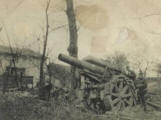            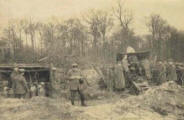    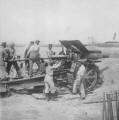            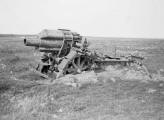 The models in these photos show the 21cm Mörser in its different modes:
The models in these photos show the 21cm Mörser in its different modes:
 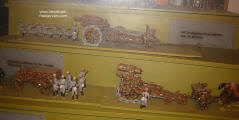
THE 21 cm MÖRSER m/16 IN DETAIL
| | | Left side.
| Right side. | The Business end. | | | | Rear view. Notice the swinging Loading Cradle.
| View to the rear and left. | View to the rear and right. | | | | The fixed (first) Earth Spade and the Towing Hook.
| Detail of the Trail. Notice the second, folding Earth Spade, operated by the long handle. | More details of the Trail. Notice the small folding platform for the Gun Layer | | | | Front detail. The Long Tube running across the front is a part of the elevating mechanism.
| Front detail. Note that the Breech is in a semi-open state. I don't know, but suspect that the colour is the original German paint, showing yet another variant of the so called Feld-Grau colour, this time the shade called Reseda-Grün. | More Front detail. | | | | This 21cm can be found in the Army Museum in Brussels. (Photo courtesy of Philippe Massin!) Here you can see the gun in a sort of semi-limbered state, with the barrel wagon in position to maneuver the barrel in place. Notice that this gun is equipped with the shield.
| The same gun, but now directly from the side. The camouflage could very well be the original one. Notice also the dial sight, absent in the gun shown above. | This rusting 21 cm was found by Mike Casales, NJ, USA, and photographed by him. | | | | The same rusting 21cm, courtesy of Mike Casale, NJ, USA.
| More photos of the same rusting 21cm, courtesy of Mike Casale, NJ, USA. | More photos of the same sadly neglected 21cm, courtesy of Mike Casale, NJ, USA. |
MORE DETAIL PHOTOS OF THE 21 cm MÖRSER
The gun below can be seen in the A6 Military Museum in Jonkoping, Sweden:
    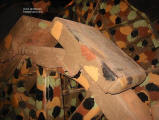  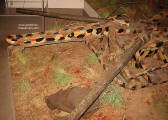  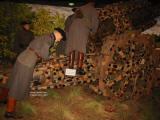   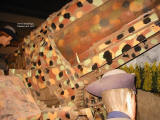  


|




























































 Similar Threads
Similar Threads

